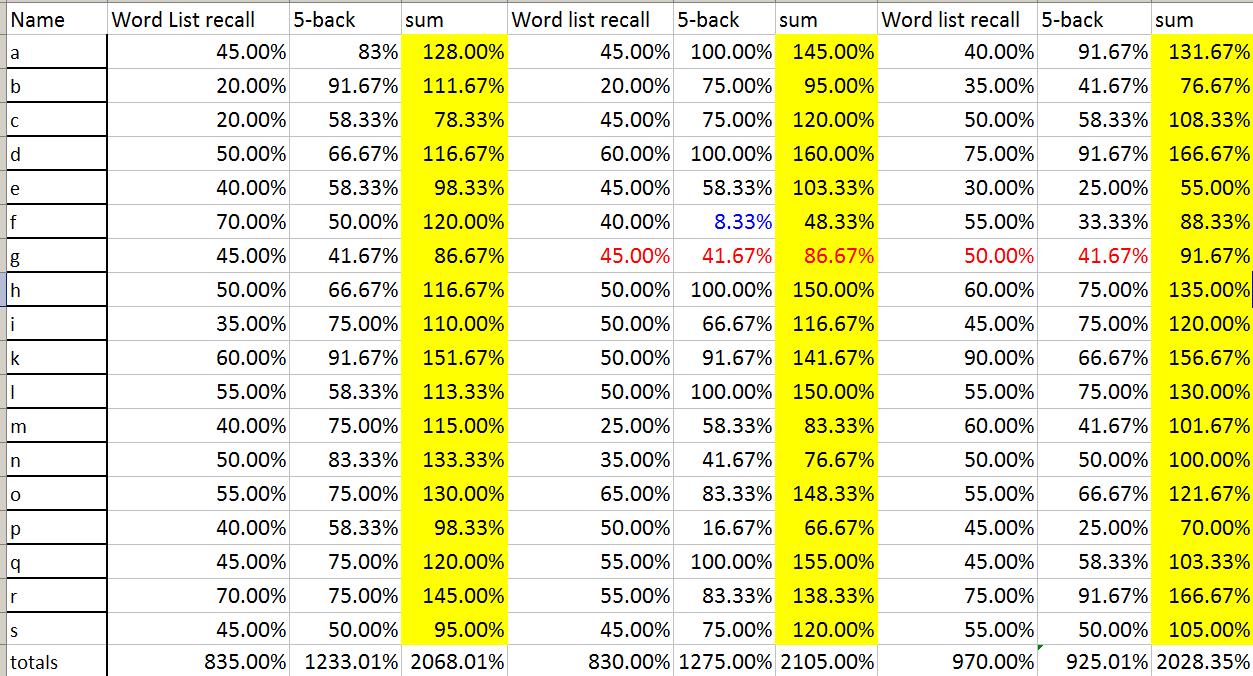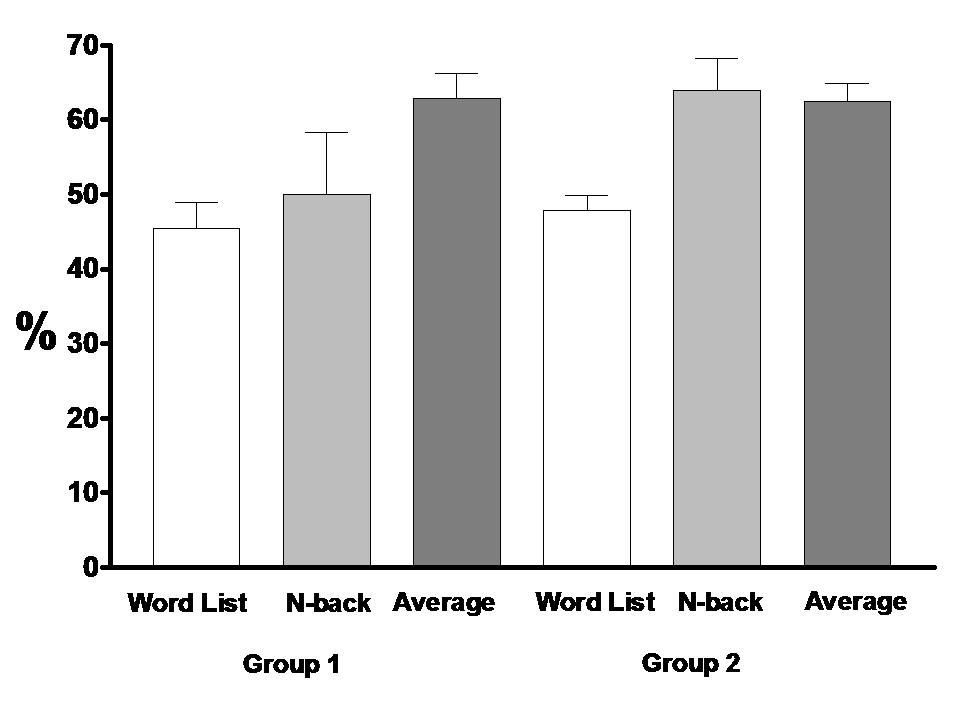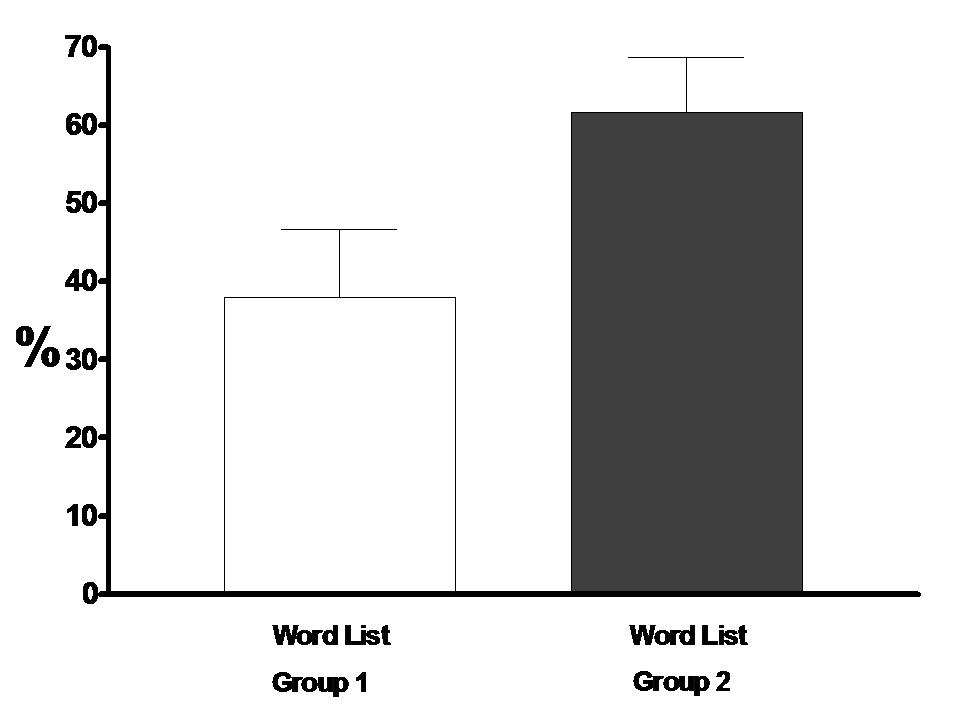
|
student results summer 09 random.xlsx Size : 0.012 Kb Type : xlsx |

The Secrets of Learning and Memory:
Attentiveness, encoding and retrieval strategies.
Andrew P Mallon
Abstract
In order to memorize and
recall information the brain is required to perform several key tasks at several
physiological and behavioral stages. We have investigated the impact of environmental
factors and physiological states on two aspects of cognitive function. In doing
so we consciously tried to mimic strategies that are realistically attainable
and reproducible in study habits.
We tested the working memory
component of the central executive functions using the n-back test and the
short- and long-term memory using the Sperling word list test. Under control
conditions 19 healthy volunteers were administered these tests and split into
pairs to form two groups that contained subjects with the same range of
ability, a control group and a test group that scored an average of 62.83 ±3.43%,
n=10 and 62.41±2.49%, n=9 respectively. Ten days later the groups underwent
different regimens and were retested. We found that the test group
significantly outperformed the control group on tests of the central executive
and short-term memory. Two days later
the subjects were again asked to recall as many of the words as they could,
again the test group significantly outperformed the control group suggesting
that long-term memory had also been improved. The impact of several variables are
postulated to have worked synergistically to produce such a profound effect. We
postulate that the significant factors in the regimens were that the test group
was fasting and well rested leading to an increased level of attention and had
the optimum opportunity of encoding the information in the same environment as the
test was administered.
These simple techniques could
be adopted to aid in mental tasks and maximize cognitive powers.
Introduction
The central nervous system
(CNS) is responsible for many varied tasks including the reception of
sensation, the coordination of muscles to produce movements, and the homeostatic
regulation of body function. However, the most fascinating aspect of the CNS is
its ability to learn new facts, collate, plan and then act upon that
information. It is the vastly superior aptitude that human beings have for this
function that greatly separates them from every other species. Of key
importance in our cognitive ability is the central executive functions found in
the large dorsal prefrontal cortex that allow us to consciously consider information
and make plans. Also, notable in humans are the extensive cortical areas that provide
the capability to encode and retrieve memories and skills that can persist from
a few seconds to a lifetime. This has freed humans from living a moment to moment
existence based on instincts and their immediate environment as found in other
species.
There has been a great deal
of research investigating what strategies can improve memory and there are
several products available that claim to improve memory. Several factors are
thought to be important including exercise level, diet, rest, stress and
caffeine intake. However, there is little consensus on how significant each
variable is either alone or in combination to elicit improvements. We have used
a control study environment based closely on the real experience of students
and designed a test environment designed to be more conducive to effective
learning. We have found that this learning environment was able to produce a
significant increase in central executive function, short- and long-term memory
retrieval.
Methods and Results
The nineteen subjects for
this experiment were aged 14-17 years that were screened and vetted for
confounding factors including alcohol, tobacco, medical and psychological
conditions.
Initially, the subjects were
given two tests in control conditions. The first test was the n-back test,
where the subjects were read a randomized list of integers from 1-9. When the integer
‘3’ was read, the subjects were instructed to write down the integer that had
been read out five steps previously. For example, in the example series 8, 4, 2,
8, 6, 2, 1, 5 and 3, the integer five steps prior to ‘3’, is ‘8’.
Subsequently, the subjects
underwent the Sperling word list test. In this test, a list of twenty neutral
words were displayed and read in a random sequence. Each word was displayed for
two seconds, at the end of the series the screen was blanked and the subjects
were instructed to hold the words in their memory. After two minutes they were
asked to write down as many of the twenty words as they could remember. The
subjects were then split into two groups that contained pairs of participants with
similar test scores producing two groups of approximately equal initial ability,
age and gender split. The subject’s names were assigned random letters of the
alphabet to blind the results from the investigators.

Fig 1 Initial scores for
group 1 and group 2.
Bar graph showing the
initial test scores of the subjects after they had been paired into two groups
of nearly equal ability. The control group initially scored 45.5±3.45% in the
word list, 50±8.33% in the n-back test and 62.8±3.43% on average across several
tests (n=10). The test group scored 47.78±2.06% on the word list, 63.89±4.39%
in the n-back test and 55.83±2.64% (n=9) on average overall.
This group was placed in a
separate classroom than the test group. During the test a radio was playing on
low volume in the background. Prior to the start of the tests the subjects were
informed that a surprise exam for the course they were taking would be administered
the next day, causing some stress. The students were then given the n-back test
and their answers were recorded. They were then read and shown a list of twenty
new words as described above. During the two minute break they were moved to an
adjoining classroom to join the test group where all subjects wrote down as
many words as they could remember.
The test group was kept in
the same classroom which they were accustomed to and the room was kept silent.
They were administered the n-back test and the scores were recorded. Then they
were given the word list with the advice to read out the words to themselves to
make use of both the auditory memory buffer and to associate the words with
images as the thought about them to better use the visual memory buffer. At the
end of the reading the control group returned to the classroom and after two
minutes all the students wrote down as many words as they could recall.
[At the end of this phase of
the testing the test groups hunger was relieved with cold pizza, warm milkshake
and potato chips.]
Two days later the subjects
were again asked to recall as many of the word list as they could remember to test
the impact on long term memory storage. As shown in Figure n the test group
significantly outperformed the control group on every test. This demonstrates a
clear advantage was acquired by the test group in these tests.
Bar graph showing the test scores of the subjects after they had been paired into two groups of nearly equal ability. The control group scored 45±4.71% in the word list, 50±9.86% in the n-back test (n=10). The Test group scored 71.11±2.74% on the word list, 77.8±6.51% in the n-back test (n=9)

Fig 3 Second experimental
phase scores for group 1 and group 2.
Bar graph showing the test
scores of the subjects after they had been paired into two groups of nearly
equal ability. The control group scored 38±8.67% in the word list (n=10). The
Test group scored 61.67±7.07% on the word list (n=9).
Discussion
There are several variables
which we consider most significant in the difference seen in this experiment.
The fasting state of the test group as compared to the satiated control groups
had a direct impact upon cognitive ability. It has been previously demonstrated
that when the stomach is empty it releases a hormone, ghrelin, that travel
through the bloodstream and acts on the brain to improve attention. This is a
logical evolutionary and survival progression. When a human is hungry it
becomes more alert and thus more likely to spot a source of food. When a human
has had a full meal, blood flow can be diverted to the gastrointestinal tract
and away from the muscles and rest of the body. When we have had a big meal the
body is shut down and often the brain automatically instigates a sleep cycle to
allow for this. It is widely perceived that the brain needs glucose to work and
lack of glucose actively circulating in the blood is deleterious to cognitive
function but this is clearly not the case. The majority of glucose released
into the blood from digestion is rapidly sequestered into the liver as glycogen
by the action of insulin. In the brain there are very numerous specialized
cells called glia which surround nerve cells and store large quantities of
glucose to feed them.
If the brain is poorly
rested it is unable to concentrate on acquiring information and it is not
encoded from sensory systems into short and long term memory but is quickly
forgotten. Being well rested, taking frequent and effective breaks and not
studying in mammoth sessions can improve this condition.
is radically different from
the testing environment will result in problems with recall. Constructing a
study environment as close to the testing area as possible or in the testing
area will improve memory recall. This includes the removal of all sensory
stimuli: sounds, smells, sights, touch and taste.